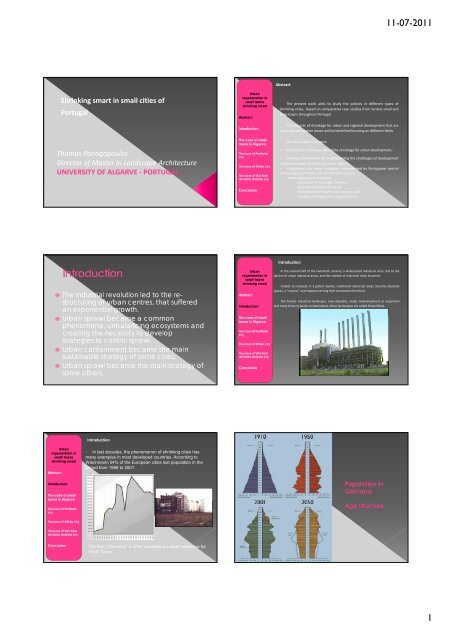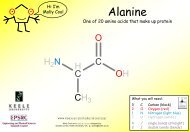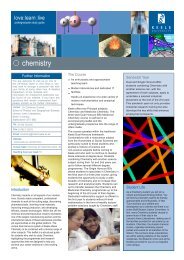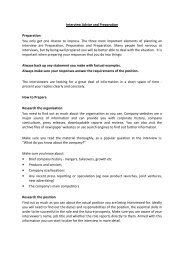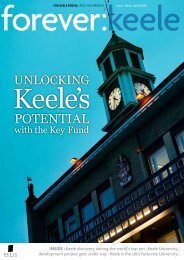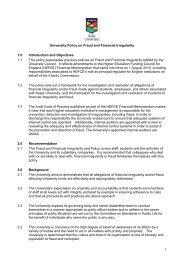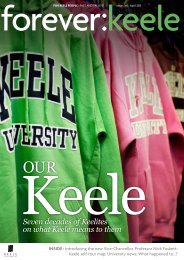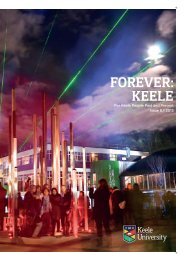Panagopoulos presentation - Keele University
Panagopoulos presentation - Keele University
Panagopoulos presentation - Keele University
Create successful ePaper yourself
Turn your PDF publications into a flip-book with our unique Google optimized e-Paper software.
11-07-2011<br />
Shrinking smart in small cities of<br />
Portugal<br />
Urban<br />
regeneration in<br />
small towns<br />
shrinking smart<br />
Abstract<br />
Introduction<br />
Abstract<br />
The present work aims to study the policies in different types of<br />
shrinking cities, based on comparative case studies from various small and<br />
large towns throughout Portugal.<br />
The impacts of shrinkage for urban and regional development that are<br />
caused by population losses will be identified focusing on different fields.<br />
Thomas <strong>Panagopoulos</strong><br />
Director of Master in Landscape Architecture<br />
UNIVERSITY OF ALGARVE ‐ PORTUGAL<br />
The case of small<br />
towns in Algarve<br />
The case of Portimão<br />
city<br />
The case of Olhão city<br />
The case of Vila Real<br />
de Santo António city<br />
Conclusion<br />
The main objectives were:<br />
• Identify the challenges caused by shrinkage for urban development;<br />
• Develop a framework for understanding the challenges of development<br />
in different types of shrinking urban regions;<br />
• Understand the major strategies implemented by Portuguese central<br />
and local governments and identify their success<br />
Some policies are analysed:<br />
promotion of marriage numbers,<br />
secondary students increase,<br />
maintenance of health care services and<br />
creation of employment opportunities<br />
Introduction<br />
The industrial revolution led to the restructuring<br />
of urban centres, that suffered<br />
an exponential growth.<br />
Urban sprawl became a common<br />
phenomena, unbalancing ecosystems and<br />
creating the necessity to develop<br />
strategies to control sprawl.<br />
Urban containment became the main<br />
sustainable strategy of some cities.<br />
Urban sprawl became the main strategy of<br />
some others.<br />
Urban<br />
regeneration in<br />
small towns<br />
shrinking smart<br />
Abstract<br />
Introduction<br />
The case of small<br />
towns in Algarve<br />
The case of Portimão<br />
city<br />
The case of Olhão city<br />
The case of Vila Real<br />
de Santo António city<br />
Conclusion<br />
In the second half of the twentieth century, a widespread industrial crisis, led to the<br />
decline of urban industrial areas, and the number of industrial cities lessened.<br />
Unable to compete in a global market, traditional industrial areas, became obsolete<br />
spaces, a “surplus” and stopped serving their production functions.<br />
The former industrial landscape, now obsolete, needs redevelopment or expansion<br />
and many times to be de‐contaminated, these landscapes are called Brownfields.<br />
Introduction<br />
Urban<br />
regeneration in<br />
small towns<br />
shrinking smart<br />
Abstract<br />
In last decades, the phenomenon of shrinking cities has<br />
many examples in most developed countries. According to<br />
Wiechmann 54% of the European cities lost population in the<br />
period from 1996 to 2001.<br />
Introduction<br />
The case of small<br />
towns in Algarve<br />
The case of Portimão<br />
city<br />
The case of Olhão city<br />
The case of Vila Real<br />
de Santo António city<br />
Conclusion<br />
The term "shrinking" is often considered a death sentence for<br />
Small Towns<br />
1
11-07-2011<br />
Urban shrinkage in the United States 2000-2004<br />
based on US Census data<br />
Lisbon is in the 10 cities with the highest relative loss of more than<br />
1.75% annually.<br />
Old industrialized cities (typical examples are Glasgow, St. Etienne, or<br />
Gelsenkirchen) has led to shrinking, in some ways similar to those in<br />
American metropolises like Detroit, Pittsburgh, and Cleveland.<br />
Suburbanization,<br />
Deindustrialization,<br />
Demographic shrinkage (aging<br />
population),<br />
Post-fordist transformations (post socialist<br />
transformation).<br />
City cycle (Athens, Rome)<br />
Globalization<br />
<br />
<br />
According to Van den Berg (1982) cities undergo through a cycle<br />
with different stages such as: urbanization, suburbanization, deurbanization<br />
and re-urbanization, that belong to a natural process,<br />
related with the city history, but are also related with the city<br />
economic position within a global market (Sassen, 2001).<br />
Shrinking cities are also a product of globalization, with a global<br />
market, the number of industrial cities lessened due to a more<br />
competitive economy (Scott and Storper, 2003).<br />
11<br />
2
11-07-2011<br />
› Local governments by offering<br />
houses or other residential<br />
advantages to young couples, try<br />
to attract new inhabitants to those<br />
municipalities<br />
› This policy is not accompanied in<br />
most cases by other policies,<br />
namely policies that promote<br />
employment or avoid speculative<br />
rent estate activity<br />
• In Lisbon and Oporto cases, real<br />
property valuation forces<br />
households to search for houses in<br />
neighbouring municipalities,<br />
despite of job opportunities<br />
• Boticas, Vinhais e Marvão that<br />
faced a reduction in the property<br />
value, did not generate<br />
employment<br />
• Almeida faces a change on<br />
employment profile: industrial<br />
employment is in decline, being<br />
the major number of jobs offered<br />
in the primary sector which is<br />
often a seasonal activity, thus not<br />
ensuring permanent residence<br />
› Intends to give residents a reason to<br />
stay by guarantying jobs opportunities<br />
› Cases in which employment in the<br />
municipalities increased without<br />
containing the abandon of inhabitants<br />
• Job opportunities are mainly in primary<br />
and secondary sectors<br />
• A factor for the success of policies<br />
promoting local employment is the<br />
capability of resilience of each<br />
municipality for adapting from<br />
activities of primary and secondary<br />
sectors into tertiary sector activities<br />
› A policy that seems to retain economic<br />
activity in interior municipalities with less<br />
than 10 thousand inhabitants like<br />
Carrazeda de Ansiães, Oleiros,<br />
Almeida, Vila Velha de Rodão or<br />
Fronteira is the practice of exemption or<br />
of a reduced rate on income tax<br />
generated by business activity called<br />
“derrama”<br />
13<br />
14<br />
Urban<br />
regeneration in<br />
small towns<br />
shrinking smart<br />
Abstract<br />
The case of small towns in Algarve, Portugal<br />
Algarve industry was mostly related with the rich fishing resources and<br />
the food‐canning industry. After the entrance of Portugal to EU, with more<br />
strict environmental laws and the exponential tourism development and<br />
globalization processes, industrial activities declined, leaving industrial derelict<br />
areas.InthisarticlewewillmentionthreecasestudiesofAlgarvetownswith<br />
shrinking problems (Portimão, Olhão and Vila Real de Santo António) , and the<br />
options taken relatively to their obsolete industrial patrimony.<br />
Urban<br />
regeneration in<br />
small towns<br />
shrinking smart<br />
Abstract<br />
The case of Portimão city (adaptive reuse of community icons )<br />
During the 19 th and 20 th<br />
centuries, Portimão sardine<br />
canning industry flourished, and<br />
its industrial landscape establish<br />
a strong connection between the<br />
fishing port, the city and the<br />
Arade river.<br />
Introduction<br />
The case of small<br />
towns in Algarve<br />
Introduction<br />
The case of small<br />
towns in Algarve<br />
In 1960s, the industry collapsed, leaving several<br />
industrial facilities to abandonment on Arade<br />
riverside, but now, this whole area was recovered.<br />
The case of Portimão<br />
city<br />
The case of Portimão<br />
city<br />
The case of Olhão city<br />
The case of Olhão city<br />
The case of Vila Real<br />
de Santo António city<br />
The case of Vila Real<br />
de Santo António city<br />
Conclusion<br />
Conclusion<br />
As part of the riverside recovery an old canning<br />
factory, Feu Factory, was turned into a municipal<br />
museum, which opened on May 17 th 2008.<br />
3
11-07-2011<br />
The case of Portimão city<br />
The case of Olhão city: Historic Preservation (building recycling)<br />
Urban<br />
regeneration in<br />
small towns<br />
shrinking smart<br />
Abstract<br />
Introduction<br />
The case of small<br />
towns in Algarve<br />
To view the museum the<br />
public can choose three different<br />
paths, the first one called “the<br />
origin and destiny of a<br />
community”, the second “the<br />
industrial life and the sea<br />
challenge” and the third one called<br />
“in deep water” is about Arade<br />
river and the ocean bottom.<br />
Urban<br />
regeneration in<br />
small towns<br />
shrinking smart<br />
Abstract<br />
Introduction<br />
The case of small<br />
towns in Algarve<br />
One of the canning<br />
industry factories in Olhão was<br />
the Ramirez factory, located<br />
near the port area and<br />
founded in 1936, that canned<br />
tuna in olive oil, sauces or<br />
brine.<br />
The case of Portimão<br />
city<br />
The case of Olhão city<br />
The case of Vila Real<br />
de Santo António city<br />
Conclusion<br />
As part of the second path,<br />
the museum maintains the<br />
factory structure, showing its<br />
functions.<br />
The case of Portimão<br />
city<br />
The case of Olhão city<br />
The case of Vila Real<br />
de Santo António city<br />
Conclusion<br />
As the canning industry<br />
in Olhão declined, this<br />
affected the Ramirez factory,<br />
that was sold to another<br />
canning company, from Vila<br />
Real de Santo António, José<br />
António Rita, Lda. This<br />
factory was recently<br />
rehabilitated<br />
and<br />
transformed into municipal<br />
auditorium.<br />
The case of Olhão city: Historic Preservation (building recycling)<br />
The case of Vila Real de Santo António city<br />
Urban<br />
regeneration in<br />
small towns<br />
shrinking smart<br />
Abstract<br />
Introduction<br />
The case of small<br />
towns in Algarve<br />
The building itself was not maintained,<br />
but as a respect for the place cultural<br />
heritage some cultural and architectural<br />
elements were identified and maintained,<br />
to transmit a sense of place.<br />
Urban<br />
regeneration in<br />
small towns<br />
shrinking smart<br />
Abstract<br />
Introduction<br />
The case of small<br />
towns in Algarve<br />
Located by the national border<br />
and near the sea, on the nineteenth<br />
century most of Vila Real de Santo<br />
António population depended on the<br />
tuna and sardine fishing and canning.<br />
As the canning industry declined, Vila<br />
Real de Santo António lost prosperity<br />
and now its economy mainly depends<br />
on tourism, and the old canning<br />
factories were left to derelict.<br />
The case of Portimão<br />
city<br />
The case of Portimão<br />
city<br />
The case of Olhão city<br />
The case of Olhão city<br />
The case of Vila Real<br />
de Santo António city<br />
The case of Vila Real<br />
de Santo António city<br />
Conclusion<br />
Conclusion<br />
Urban<br />
regeneration in<br />
small towns<br />
shrinking smart<br />
Abstract<br />
Introduction<br />
The case of small<br />
towns in Algarve<br />
The case of Vila Real de Santo António<br />
city<br />
The local government is planning to<br />
rehabilitate this derelict industrial area with<br />
residential buildings, a technological park<br />
and a green open space with leisure<br />
activities.<br />
Although, the presented project has no<br />
regard for the cultural heritage of that<br />
industrial landscape, neither for the cultural<br />
patrimony that all city buildings represent, it<br />
aims for some of the populations wishes.<br />
The case of Portimão<br />
city<br />
The case of Olhão city<br />
The case of Vila Real<br />
de Santo António city<br />
Conclusion<br />
(font: http://www.cm‐vrsa.pt/NR/rdonlyres/BC871D11‐949B‐42E2‐8AEE‐6ED249BED810/0/1_planta_implanta%C3%A7%C3%A3o.pdf).<br />
4
11-07-2011<br />
O programa<br />
O lugar<br />
- The intrvention area is between 2<br />
canning factory intalations,<br />
abandoned and degradeted,<br />
that incude a weltand, zone of<br />
salt marches and the Delta of rio<br />
Gilão.<br />
- Recuperar a zona industrial<br />
e área envolvente com o<br />
intuito de valorizar o<br />
património industrial,<br />
cultural e paisagístico.<br />
- Recuperar a galeria ripícola,<br />
visto que esta se reveste<br />
de extrema importância.<br />
- Recuperar o sapal, de modo<br />
a promover a<br />
manutenção da<br />
biodiversidade.<br />
- Recuperar as salinas<br />
inactivas de modo que<br />
evoluam novamente<br />
para sapal.<br />
- Conciliar e integrar as<br />
estruturas pré-existentes<br />
no novo desenho do<br />
espaço.<br />
Pretende-se, deste modo,<br />
que o parque<br />
proporcione diversas<br />
actividades de recreio e<br />
lazer a todas as faixas<br />
etárias, promovendo a<br />
qualidade estética e<br />
ambiental e as vivências<br />
sociais.<br />
The quarry of Braga transformation to Stadium for<br />
Euro 2004<br />
Cost 161 million euro<br />
The Braga Stadium was projected by the architect<br />
E. Souto Moura and constructed in a derelict quarry<br />
located in the urban area of Braga in the North of<br />
Portugal.<br />
Creation of multifunctional landscapes, which is<br />
the example of the Braga Municipal Stadium,<br />
which was created on the mountainside by<br />
levelling down a quarry of the mountain Monte<br />
Castro and served as a hosting venue for the Euro<br />
2004 tournament.<br />
The project offers an unusual and innovative frame<br />
and his architecture is a sequence of sustainable<br />
decisions which should be listed and analysed.<br />
The stadium is just a part of the sports complex built in<br />
an area occupying more than 74 acres. A space that<br />
includes the stadium, Olympic pools, and several other<br />
multifunctional facilities all linked by numerous accesses<br />
where it is possible to contact with nature, feeling the<br />
spirit of the old landscape – the quarry.<br />
5
11-07-2011<br />
The tiers go across the entire playing field and resemble<br />
the ancient and rusticated bridges that were constructed<br />
by the Incas.<br />
The vegetation<br />
was used to<br />
increase the<br />
quality of the<br />
place, by creating<br />
alignments that<br />
direct people to<br />
the different areas<br />
of the project.<br />
Park Tejo-Trancão is one of the best examples of a postindustrial<br />
landscape reclamation project ever realized in<br />
Portugal.<br />
It is located in the oriental part of Lisbon, in the right margin of<br />
the river Tejo, in a transition area between the municipal<br />
districts i t of Lisbon and Loures.<br />
Before being a park, this area was composed by several<br />
industrial structures (a landfill, scraps, a sewage treatment<br />
plant and some obsolete industrial buildings. The high indexes<br />
of contamination and degradation of this landscape, the<br />
proximity of the Natural Reserve of the Estuary of Tejo and the<br />
intention to develop the world exposition Expo'98 constituted<br />
decisive arguments for the intervention in this specific area.<br />
With approximated 90ha, the park links physics and<br />
thematically with the Park Expo'98.<br />
6
11-07-2011<br />
The shrinking city syndrome is leaving planners and<br />
city officials with, among other things, the<br />
challenge of preserving and reusing buildings with<br />
architectural and cultural interest.<br />
A regenerated former mining settlement in Gelsenkirchen.<br />
<br />
<br />
<br />
From 146 active mines in 1960 only 7 remain today<br />
From 4.5 milion people only 2 milion<br />
From 607.000 miners only 39.000 today<br />
1992 1998 2003<br />
The Zollverein industrial complex<br />
in Ruhr-Germany consists of a<br />
historical coal-mining site<br />
infrastructure, with some 20thcentury<br />
buildings of outstanding<br />
architectural merit due to<br />
application of the design<br />
concepts of the Modern<br />
Movement in architecture in the<br />
industrial context.<br />
<br />
It constitutes t remarkable<br />
material evidence of the<br />
evolution and decline of an<br />
essential industry over the past<br />
150 years.<br />
It has been inscribed into the<br />
UNESCO list of World Heritage<br />
Sites since December 14, 2001<br />
and is one of the anchor points<br />
of the European Route of<br />
Industrial Heritage.<br />
7
11-07-2011<br />
The Duisburg-Nord Landscape Park combines the industrial<br />
cultural heritage, Nature and a Light-show.<br />
What the visitor finds here is a massive industrial wasteland,<br />
measuring 200 hectares, which has been transformed over a<br />
period of more than ten years into a multifunctional park.<br />
At the centre of the park there is a decommissioned<br />
metalworks, the old industrial facilities of which are today<br />
being put to a variety of different uses.<br />
The former factory buildings have been converted to<br />
accommodate cultural and corporate functions; an old<br />
gasholder has become the biggest artificial diving centre in<br />
Europe; alpine gardens have been created in the ore<br />
storage bunkers, and a blast furnace has been developed<br />
into a panoramic tower.<br />
8
11-07-2011<br />
9
11-07-2011<br />
10
11-07-2011<br />
Conclusion<br />
Urban<br />
regeneration in<br />
small towns<br />
shrinking smart<br />
Abstract<br />
Introduction<br />
The case of small<br />
towns in Algarve<br />
The case of Portimão<br />
city<br />
The case of Olhão city<br />
The case of Vila Real<br />
de Santo António city<br />
Conclusion<br />
Urbanization is the main driving force of environmental change and “urban<br />
sprawl” become the model of urban development worldwide in the last<br />
decades before it blamed for many social and environmental problems.<br />
The “Smart Growth” and “New Urbanism” movements have made strong<br />
appeals to restrain city expansion.<br />
In this work we compare small size towns of Algarve with shrinking<br />
neighbour problems that choose to rehabilitate derelict areas instead of<br />
expanding into green areas in their effort to be appropriate with the<br />
sustainable city development and smart growth principles.<br />
Some of the study towns of Algarve respect and reuse their recent history<br />
facilities, some others choose to ignore it. The project always gave an added<br />
value. We compare with international projects that had the ability to attract<br />
large investment.<br />
Public officials, planners and residents often try to "solve" the condition of<br />
shrinking, applying the same tool kit used for growth, with little success. Our<br />
general conclusion is that providing alternative multifunctional solution for the<br />
obsolete industrial patrimony may award us for a long term sustainable<br />
solution.<br />
<br />
<br />
8th WSEAS International Conference<br />
on<br />
Energy, Ecosystems, Environment and<br />
Sustainable Developmend (EEESD´12)<br />
5th WSEAS International Conference on<br />
Landscape Architecture (LA´12)<br />
Jon Burley – School of Planning, Design, and<br />
Construction, Michigan State <strong>University</strong>,<br />
USA.<br />
Chris Zegras, MIT, USA. “Strategic t Options<br />
for Integrating Transportation Innovations<br />
and Urban Revitalization” MIT-Portugal<br />
Program<br />
Prof. Pedro Abramo - Universidade Federal<br />
do Rio de Janeiro, Inst. Pesquisa e<br />
Panejamento Urbano e Regional, Brazil.<br />
The conference will be held at the<br />
Auditorium of the Faculty of Economics<br />
<strong>University</strong> of Algarve, Campus de<br />
Gambelas, in Faro.<br />
<br />
Hotel Eva<br />
* * * *<br />
Address:<br />
Av. da República,1<br />
8000-078 Faro<br />
Phone: +351 289 001 000<br />
Fax: +351 289 001 002<br />
Email: eva@tdhotels.pt<br />
Site: www.tdhotels.pt<br />
Downtown<br />
Room Prices<br />
Single 93.00 €<br />
Double 109.00 €<br />
11
11-07-2011<br />
12


